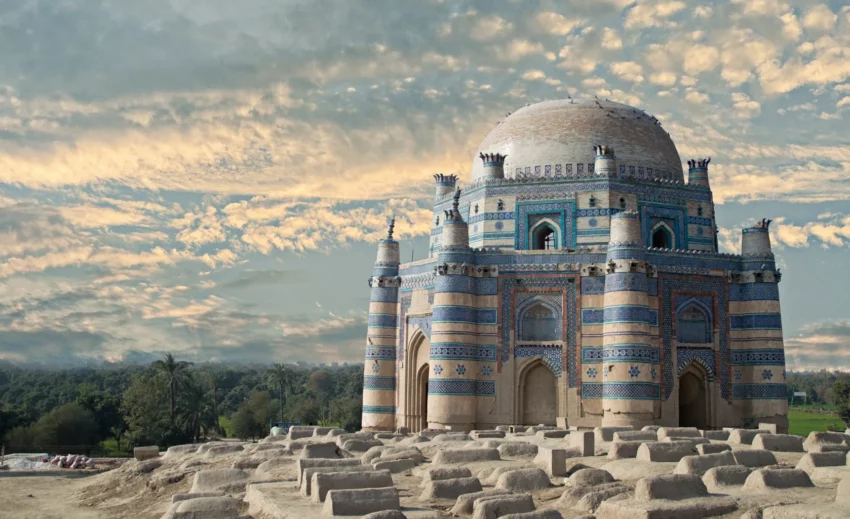Get your dose of History via Email
Introduction to the Tomb of Bibi Jawindi
The Tomb of Bibi Jawindi, with its unique architectural style, is one of the most significant monuments in Uch, located in the Punjab province of Pakistan. This historical mausoleum, which dates back to the 15th century AD, was built in 1493 by the Iranian prince Dilshad for Bibi Jawindi, the great-granddaughter of Jahaniyan Jahangasht, a renowned Sufi saint. Over the years, the site has attracted attention not only for its spiritual significance but also for its architectural excellence and intricate decorative elements.
Architectural Significance
The Tomb of Bibi Jawindi stands as a testament to the sophistication of Tughluq architecture, reflecting influences that range from Central Asia to Persia. This five-story structure was once adorned with a dome, now collapsed, and features a notable use of glazed tiles in its intricate decoration, with blue and white being the dominant colors. The aesthetic appeal further lies in the ornamental calligraphy, geometric designs, and the overall symmetry of the building’s design. The tile work demonstrates the artistic excellence of that era, as well as the skilled craftsmanship of the artisans of that region.
Cultural and Religious Implications
The construction of the tomb is deeply connected to the spiritual importance of its inhabitant, Bibi Jawindi. She was a revered Sufi personality whose influence in the region was undeniable. The site functions not just as a historical landmark but also a sacred space that has long been visited by pilgrims and devotees seeking blessings and spiritual inspiration. As with other Sufi sites, the tomb also serves as a focal point for local religious festivities and practices, and it plays a vital role in the continuation of cultural and spiritual traditions in the region.
UNESCO World Heritage Status and Conservation Efforts
Recognized for its historical and architectural significance, the Tomb of Bibi Jawindi is part of the Uch Monument Complex listed under Pakistan’s tentative UNESCO World Heritage Sites. However, the site faces the looming threat of structural deterioration due to environmental conditions, specifically salinity and improper drainage in the surrounding area. Conservation efforts have been sporadic and largely insufficient. In response to this, the site was placed on the World Monuments Watch list by the World Monuments Fund in 1998 and 2000. These listings aimed to bring attention to the urgent need for preservation work to protect this invaluable piece of heritage from irreversible damage.
Challenges in Preservation
Preservation of the Tomb of Bibi Jawindi has encountered various obstacles. The unique architectural features and the use of glazed tiles necessitate specialized conservation techniques, which are not always readily available locally. Moreover, climatic adversities have taken a toll on the structures within the Uch Monument Complex, particularly on the Tomb of Bibi Jawindi. Human neglect and lack of education regarding the importance of such sites have also contributed to the degradation of the tomb. Therefore, addressing these challenges is crucial to ensuring that this historical monument is preserved for future generations to appreciate and learn from.
Conclusion
The Tomb of Bibi Jawindi is more than just a mausoleum; it is a cultural beacon that speaks volumes about the region’s historical and architectural traditions. It embodies the influence of Sufism within South Asia and showcases the blending of different artistic styles. The site’s significance extends beyond its physical embodiment, highlighting a rich tapestry of history, spirituality, and artistry. Preserving such a monument is critical, not only to honor the past but also to ensure its stories and lessons continue to resonate with the future. Highlighting the Tomb of Bibi Jawindi’s importance through scholarly engagement and restoration endeavors ensures that this jewel of the 15th century remains part of our shared world heritage.
Sources: Wikipedia


1 thought on “Tomb of Bibi Jawindi”